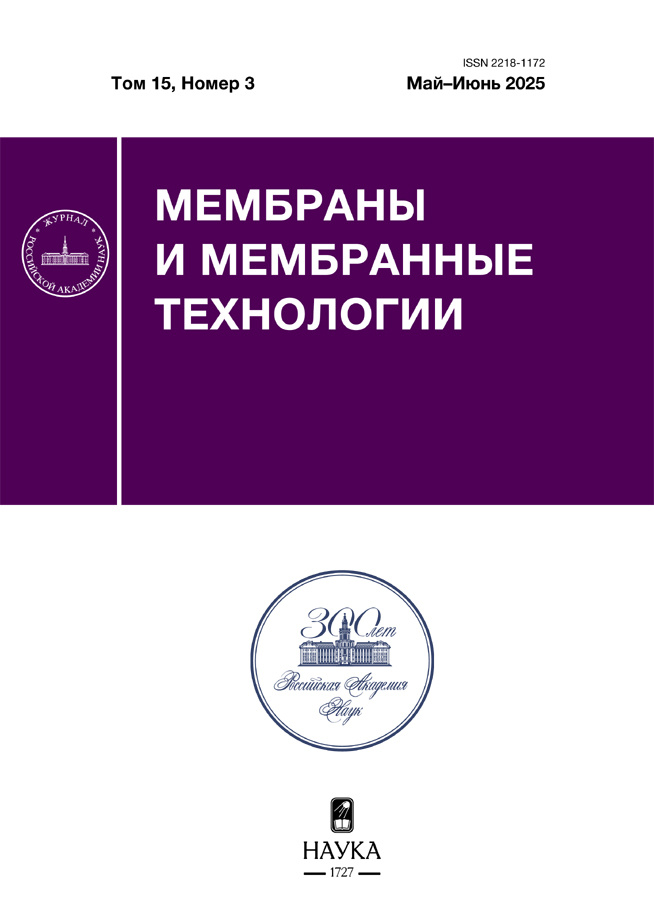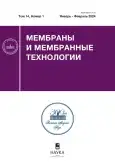Том 14, № 1 (2024)
Моделирование переноса ионов в трехслойной системе с ионообменной мембраной на основе уравнений Нернста–Планка и тока смещения
Аннотация
Моделирование переноса ионов в трехслойной системе, содержащей ионообменную мембрану и два смежных с ней диффузионных слоя, позволяет описывать селективность мембраны путем определения плотности ее фиксированного заряда. Для теоретического анализа переноса ионов в таких системах широко используются уравнения Нернста–Планка и Пуассона. В статье показано, что в гальванодинамическом режиме функционирования мембранной системы, когда задается плотность протекающего тока, уравнение Пуассона в модели переноса ионов может быть заменено на уравнение для тока смещения. Построена новая модель в виде краевой задачи для системы уравнений Нернста–Планка и уравнения для тока смещения, на основе которой рассчитаны концентрации ионов, напряженность электрического поля, плотность пространственного заряда и хронопотенциограмма ионообменной мембраны и смежных с ней диффузионных слоев в режиме постоянного тока. Результаты расчета предлагаемой модели хорошо согласуются с результатами моделирования на основе ранее описанного подхода с использованием уравнений Нернста–Планка и Пуассона, а также с аналитической оценкой переходного времени. Показано, что в случае трехслойной геометрии задачи требуемая точность численного расчета с использованием предлагаемой модели достигается при меньшем количестве элементов вычислительной сетки и занимает меньше (в 26.7 раза для рассматриваемых параметров системы) процессорного времени по сравнению с моделью на основе уравнений Нернста–Планка и Пуассона.
 3-12
3-12


Межслойное сопротивление бислойной мембраны газопереносу
Аннотация
Для описания газопереноса через бислойную мембрану с тонким селективным слоем на поверхности высокопроницаемого промежуточного слоя впервые предложено учитывать межслойное сопротивление, возникающее на границе двух мембранных слоев, и разработана модель газопереноса через бислойную мембрану. Получены аналитические выражения для проницаемости и селективности такой мембраны с учетом этого сопротивления. Показано, что межслойное сопротивление может заметно влиять на транспортные характеристики мембраны. Установлено, что даже в случае малого диффузионного сопротивления газопереносу промежуточного слоя, его сорбционные и кинетические параметры влияют на проницаемость и селективность мембраны в целом.
 13-18
13-18


Перспективы развития водородной энергетики. Полимерные мембраны для топливных элементов и электролизеров
Аннотация
В связи с повышенным вниманием к водородной энергетике и принятием многими странами программы ее развития, актуальным становится вопрос о перспективах этого направления. Изначально в программе развития водородной энергетики, принятой в России, основной акцент делался на получение водорода из природного газа. Однако в связи с изменившейся международной обстановкой и провозглашенным курсом на использование “зеленого” водорода, получение которого не связано с выбросом оксидов углерода, становится очевидным, что следует уделять особое внимание разработке топливных элементов (ТЭ) и электролизеров. В данном обзоре сопоставлены основные достоинства и недостатки ТЭ различных типов. На сегодняшний день наиболее развитой является индустрия низкотемпературных ТЭ на протонпроводящих мембранах, которые в англоязычной литературе обычно называют ТЭ на протонообменных мембранах (proton exchange membrane fuel cell). В то же время перспективными являются и ТЭ на анионообменных мембранах с проводимостью по ОН- ионам. Их несомненным преимуществом является возможность использования существенно более дешевых неперфторированных мембран и бесплатиновых катализаторов. Значительное внимание в обзоре уделено и ТЭ, позволяющим работать при повышенных температурах.
Во второй части обзора подробно рассмотрены мембраны, используемые в данных устройствах в настоящее время, и перспективные материалы, которые могут заменить их в ближайшем будущем.
 19-32
19-32


Cинтез и газотранспортные свойства полинафтоиленбензимидазолов с кето- и сульфоновой мостиковыми группами
Аннотация
В работе получены полинафтоиленбензимидазолы (ПНБИ) с кето- (ПНБИ-СО) и сульфоновой (ПНБИ-SO2) мостиковыми группами твердофазной полициклизацией пленок соответствующих полиаминоимидов (ПАНИ), синтезированных методом поликонденсации диангидрида 1,4,5,8-нафталинтетракарбоновой кислоты с 3,3`,4,4`-тетрааминобензофеноном и 3,3`,4,4`-тетрааминодифенилсульфоном в N-метилпирролидоне соответственно. Процесс поликонденсации и химическое строение образующихся ПАНИ и ПНБИ контролировали методами ЯМР 1Н, ЯМР 13С и ИК-спектроскопии. Показано, что варьирование температуры твердофазной полициклизации позволяет получать полимеры различной степени циклизации. Получены экспериментальные значения коэффициентов проницаемости и диффузии газов для He, H2, N2, O2, CO2, CH4, а также рассчитаны коэффициенты растворимости этих газов и величины идеальной селективности для различных пар газов. Установлено, что по соотношению проницаемость – селективность полностью циклизованные ПНБИ имеют преимущество по сравнению с не полностью циклизованными, что следует учитывать при выборе полимера и способа формирования селективного слоя новых композиционных мембран. Достигнутые для полностью циклизованного ПНБИ-SO2 газотранспортные характеристики, а также хорошие пленкообразующие свойства наряду с очень высокой термостабильностью полимеров этого класса представляют большой интерес с точки зрения дальнейшего расширения диапазона получаемых ПНБИ, а также перспектив применения новых полимеров этого класса в различных газоразделительных процессах.
 33-45
33-45


Разделение водонефтяной эмульсии полиамидными мембранами, обработанными плазмой коронного разряда
Аннотация
Проведены исследования по разделению водонефтяной эмульсии полиамидными мембранами с размером пор 0.2 мкм, обработанными плазмой коронного разряда при напряжении 5–25 кВ и времени 1–5 мин. Выявлено увеличение производительности и эффективности разделения водонефтяной эмульсии коронообработанными полиамидными мембранами. Показано увеличение шероховатости и изменение химической структуры модифицированных мембран.
 46-52
46-52


Поли(уретан-имиды) и поли(эфир-имиды) как перспективные материалы для разработки газоразделительных и первапорационных мембран
Аннотация
В настоящем обзоре представлены разделительные свойства мембран на основе поли(уретан- имидов) – полимеров, являющихся современными продуктами химической модификации полиимидов и полиуретанов. Обзор мембранных свойств поли(уретан-имидов) основан на принципах их химического дизайна. Рассмотрены мембраны на основе: мультиблочных (сегментных) полимеров, полиимидов, сшитых полиуретанами, гибридных поли(уретан-имидных) материалов, поли(уретан-имидов), подвергнувшихся селективной деструкции уретановых блоков. В рассматриваемых случаях даются представления об основных направлениях синтеза мембранных поли(уретан-имидов), приводятся исходные вещества и условия проведения реакций. Подробно приведены транспортные и разделительные свойства поли(уретан-имид)ных мембран в процессах газоразделения, первапорации и ультрафильтрации. Описаны применения, для которых разрабатывались поли(уретан-имидные) мембраны. В целом, дается представление о значимости поли(уретан-имидных) газоразделительных и первапорационных мембран для процессов разделения.
 53-66
53-66


Памяти Владимира Алексеевича Шапошника
 66-66
66-66












